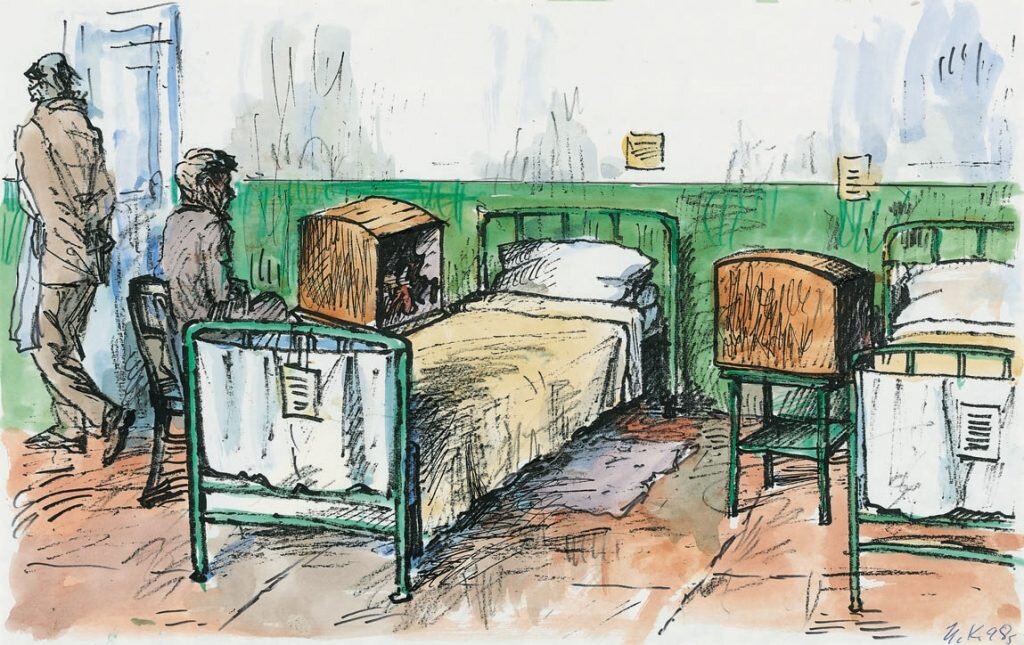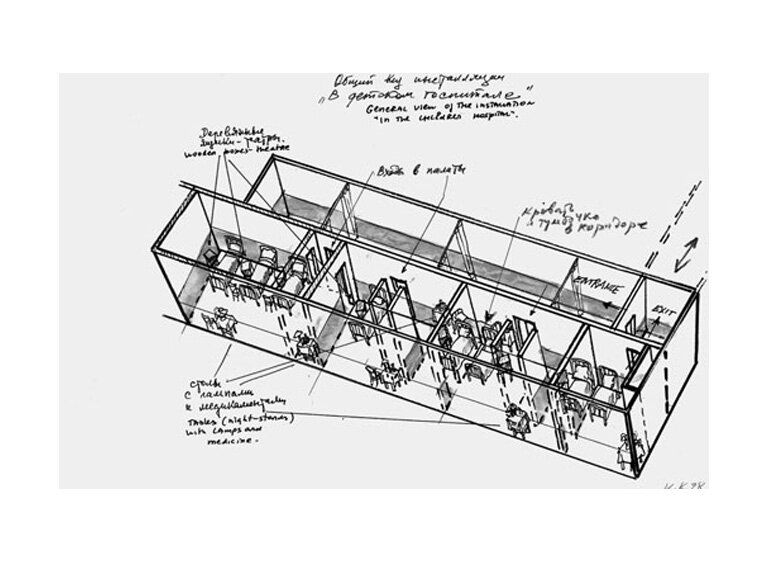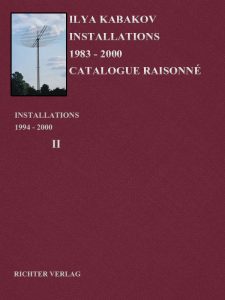The Children's Hospital
with Emilia Kabakov
YEAR: 1998
CATALOG NUMBER: 139
PROVENANCE
Collection Irish Museum of Modern Art, Dublin, (Achilles and the Turtle, The Mysterious Exhibition), since 1999.
Collection Kunstmuseum Bern, Hermann und Margrit Rupf-Foundation (Medusa’s Raft), since 2000.
Collection of the artist.
EXHIBITIONS
Irish Museum of Modern Art, Dublin, Ireland, United Kingdom
Ilya and Emilia Kabakov. The Children’s Hospital, 20 November 1998 – 11 April 1999.
Irish Museum of Modern Art, Dublin, Ireland, United Kingdom
Lifescapes: Works from the Collection, 2 October 1999 – 7 April 2000 (only Achilles and the Turtle and The Mysterious Exhibition).
Kunstmuseum Bern, Berne, Switzerland
Ilya Kabakov – 50 Installationen, 7 April – 25 June 2000 (only Medusa’s Raft and An Earthquake in The Seraglio).
Museum Wiesbaden, Wiesbaden, Germany
Ilya Kabakov – 50 Installationen, 3 December 2000 – 4 March 2001 (only Medusa’s Raft and An Earthquake in The Seraglio, prolonged until 10 June 2001).
Rotonda della Besana, Milan, Italy
Stanze e Segreti, 11 April – 28 May 2000 (only Repulsive George and His Friend Coco).
Galeria Lia Rumma, Naples, Italy
Il bambino Malato, 25 November 2000 – 28 February 2001 (only Repulsive George and His Friend Coco).
Kunstmuseum Bern, Berne, Switzerland
Zeitmaschine. Oder: Das Museum in Bewegung, 22 March – 21 July 2002 (only Medusa’s Raft).
CONCEPT AND DESCRIPTION OF THE INSTALLATION
The installation represents a suite of rooms (hospital exam rooms in which white curtains hang over the doors, the lower part of the wall is painted a light green color to a height of 1.06 meters). The lighting is ‘normal,’ daylight. In general, the layout of the existing rooms and corridors is used – after all, the original building was, in fact, a real hospital before a museum of contemporary art was located here.
The ‘salt’ of the entire installation is the 9 objects which are standing near each of the beds. These are unique sorts of small musical theaters which have been placed here to entertain the sick children lying in the beds. But the little theaters have their stages turned in such a way that the ‘visitor’ coming to visit the child can see everything that goes on in the theater. Inside each, in addition to the actual ‘action,’ music can be heard, and against this background human speech is audible – a story is being read that is connected to the events transpiring on stage. It should also be added that each such stage has its own lighting coming from special little lamps. There is a chair next to each bed, perhaps even 2, and sitting on it, one can quietly view and listen to all that transpires there. The sound ‘works’ quite softly so that two theaters, even if they are in the same room, won’t interfere with one another.
SCENES IN THE LITTLE THEATERS
Here are brief summaries of the scenes which the viewer can see when he glances into the theaters.
‘Resourceful Bigo (Carousel of ‘Straight’ and ‘Crooked’)’ A metal spiral is slowly rotating in the center, with its top tipped over. To the right and left of it there are two semi-circular pavilions made of white cloth. In the center of each of them is a small stage. Things ‘appear’ on these stages one at a time. On the left are various objects that have a strictly straight geometrical shape: pyramid, cylinder, cube, parallelepiped. On the right are objects of the same size but of intricately bent or crooked shapes. All of this together forms a slowly revolving geometrical theater. The music is also ‘metallic,’ arrhythmic.
‘Mysterious Exhibition (The Red Circle)’ The stage represents a room with a door deep inside it. In the foreground is a group of people – all of them are standing still watching the distant stage. On the stage, across virtually its entire surface, is a thick frame painted a dark orange color. A red circle slowly revolves inside the very center of the frame. One of the personage- viewers is also slowly revolving in a circle. There is no furniture in the room, it is all empty. The walls and the floor are dark, everything has a dark brown tint. The music is slow, ‘classical.’
‘Achilles and the Turtle’ The scene depicts a glade between cliffs. In the distance there are mountains, disappearing in rows one after the other. There are two characters on stage: Achilles and the Turtle. The plot is taken from the famous logical paradox, well known since antiquity: Can Achilles catch the Turtle? In our play, Achilles and the Turtle move along either side of the same axis at one and the same speed. When one side of the flat figure cut out of plywood is facing us, a turtle is depicted. When it turns around the circle, we see the other side, on which is depicted Achilles. Hence, Achilles and the Turtle, like Janus, look like one being with two images. The music is that of a long, drawn-out flute.
‘Repulsive George and his Friend Coco (A Stroll)’ The stage looks like a large white cylinder, covered on both sides with semi-closed white curtains. In the center of the cylinder is a small stage. Onto this stage emerge an apple, a glass, a perfume bottle, a pear, a jar of glue, a tomato, a porcelain figure, a spool of thread. These objects appear on stage slowly, at brief intervals, in a rather strange, incomprehensible order. Appearing slowly from the left side, they disappear to the right. A children’s song is playing.
‘Extraordinary Pirouettes (Flying ‘Figures’)’ The stage depicts a flat airfield. One airplane is standing on the left. To the right, there are two old-model airplanes – bi-planes with propellers. There is a group of ‘pilots’ in the middle. A blue sky with clouds is depicted on the back wall of the stage. Three airplanes can be seen in the sky circling, executing aerobatics. The shining sun is depicted nearby. The music is lively, parade music.
‘Medusa’s Raft’ The stage depicts a paraphrase of the famous painting by E. Géricault of the same name. In the foreground is the raft with the sail and the seafarers saved on the raft. The raft slowly rocks on the ‘waves.’ Dolphins jumping out of the sea can be seen behind the raft. The music is dramatic, ‘despondent.’
‘An Earthquake in the Seraglio’ The stage depicts the inside of an Eastern ‘seraglio’: in the foreground are spiral columns, in the background, there is a door. There are low couches along all three sides of the room. There is a large carpet in the middle on the floor. ‘Eastern’ elders are sitting on it, conversing. There is a bowl of fruit in front of them, and a chalice of wine. One part of the carpet periodically flinches from weak shocks from below. The elders sitting on that part of the carpet jump. The music is unhurried, ‘Eastern.’
‘Morning Callisthenics (Morning Exercises)’ On stage is a room that is simultaneously a bedroom and an office. There is a human figure doing calisthenics in the middle on the rug. On the left is a window letting in sunlight. A strong wind is also blowing in through that very same window. The wind is blowing so strongly that the curtains hanging on the windows are blowing, and everything in the room is flying around in the air: papers, books, other junk. The physical fitness buff, not noticing this chaos, continues to do his exercises as though nothing were happening. The music is rhythmic, lively.
‘The Old Suitcase’ A very old, dark brown leather suitcase is standing on the stage in the foreground. There are two holes gnawed through the floor in the right and left corners, through which can be seen two mice dancing funnily. The music is playing a ‘mouse’ dance.
Each of these shows is accompanied by commentary in a male voice.
All the ‘little theaters’ are fixed on wooden legs and are equipped in the front with roof shutters that slightly resemble the small wandering marionette theaters, and also the mechanical theater of the 18th Century.
VOICE IN THE INSTALLATION FOR ‘ACHILLES AND THE TURTLE’
Listen to this old mathematical fairy tale riddle thought up by a certain ancient Greek mathematician-philosopher in the 5th Century B.C. The riddle is called: “Can Achilles catch the turtle?” All the best minds of the past 2000 years have wracked their brains over this, and no solution has yet been found. Perhaps you will be lucky enough to find it?
Herein rests the difficulty of the problem: in order for Achilles to catch the turtle, he has to reach the place where the turtle is located. But as soon as Achilles reaches that place, the turtle takes a few more steps and moves from that spot. Achilles again approaches that spot where he sees the turtle, and again during that time the turtle takes a few more steps and leaves that spot. No matter how quickly Achilles moves to the spot where he sees the turtle, the turtle still manages to move away, if only the tiniest distance. It turns out that the fast-footed Achilles cannot catch the ‘slowmoving’ turtle, and the two of them – the chaser and the chased – are doomed to their eternal race forever.
Images
Literature





